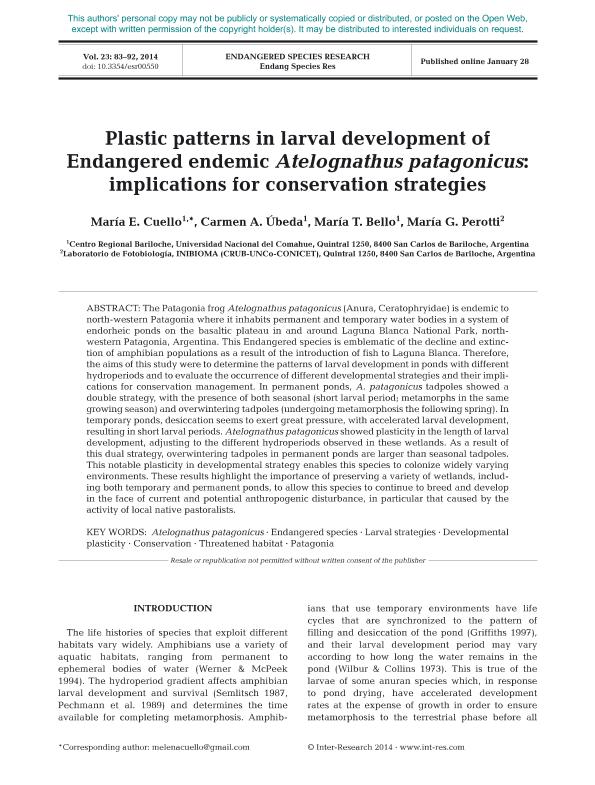Artículo
Plastic patterns in larval development of threathened endemic Atelognathus patagonicus (Anura, Neobatrachia). Implications for conservation strategies
Fecha de publicación:
02/2014
Editorial:
Inter-Research
Revista:
Endangered Species Research
ISSN:
1863-5407
Idioma:
Inglés
Tipo de recurso:
Artículo publicado
Clasificación temática:
Resumen
The endemic frog Atelognathus patagonicus lives in permanent and temporary water bodies in a system of endorheic ponds on the basaltic plateau in Laguna Blanca National Park and surroundings, in north-western Patagonia, Argentina. This species is an emblematic example of the decline and extinction of amphibian populations as a result of the introduction of fish. It is categorized as ?Endangered? by IUCN. The aims of the study were to determine the patterns of larval development in ponds with different hydroperiods and evaluate the occurrence of different developmental strategies and their implications for conservation management. In permanent ponds, A. patagonicus tadpoles showed a double strategy, with presence of seasonal tadpoles (short larval period; metamorphs in the same growing season) and overwintering tadpoles (tadpoles undergoing metamorphosis the following spring). In temporary ponds, desiccation seems to exert great pressure, with accelerated larval development, resulting in short larval periods. Atelognathus patagonicus showed plasticity in the length of larval development, adjusting to the different hydroperiods observed in these wetlands. As a result of this dual strategy, overwintering tadpoles in permanent ponds are larger than seasonal tadpoles. This notable plasticity in development strategies would enable it to colonize environments as widely varying as those analyzed in this study. These results highlight the importance of preserving a variety of wetlands, including both temporary and permanent ponds, to allow this species to continue to breeding and developing in the face of current and potential human disturbance, in particular, any caused by the activity of local native pastoralists.
Archivos asociados
Licencia
Identificadores
Colecciones
Articulos(INIBIOMA)
Articulos de INST. DE INVEST.EN BIODIVERSIDAD Y MEDIOAMBIENTE
Articulos de INST. DE INVEST.EN BIODIVERSIDAD Y MEDIOAMBIENTE
Citación
Cuello, María E.; Ubeda, Carmen A.; Bello, María T.; Perotti, Maria Gabriela; Plastic patterns in larval development of threathened endemic Atelognathus patagonicus (Anura, Neobatrachia). Implications for conservation strategies; Inter-Research; Endangered Species Research; 23; 2-2014; 83-92
Compartir
Altmétricas




